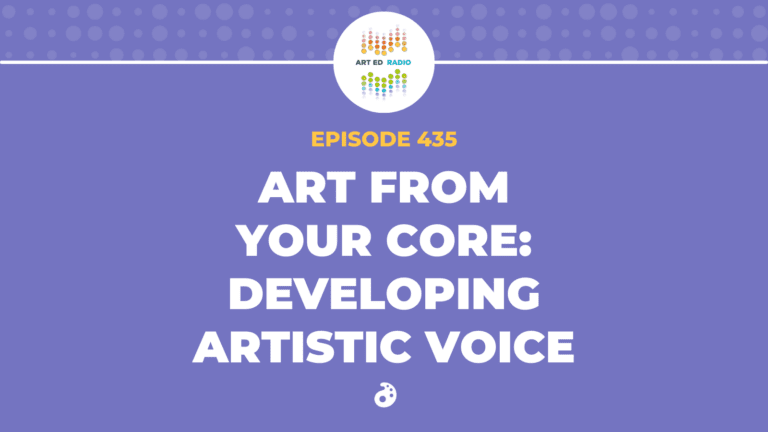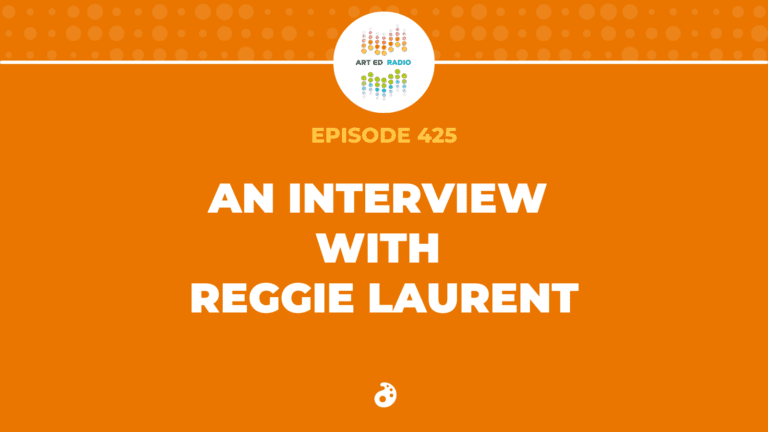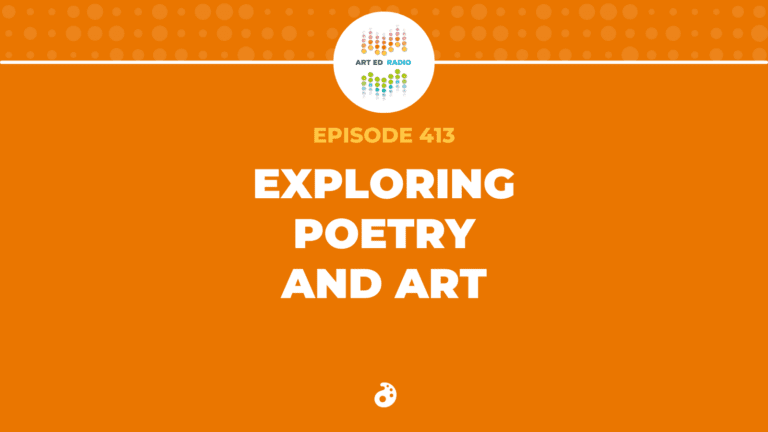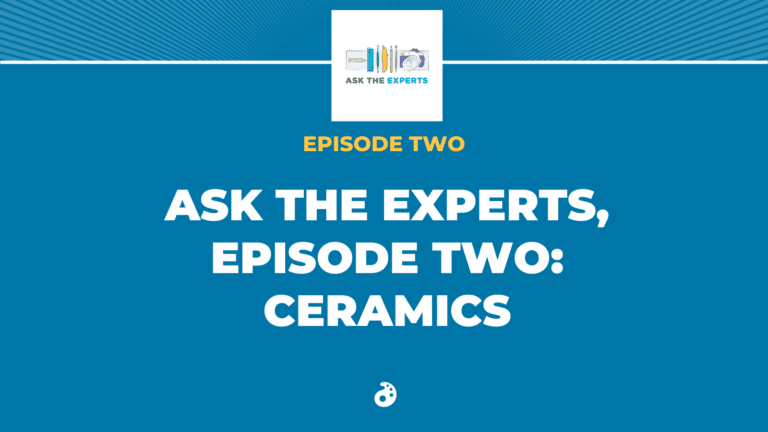Today, Tim talks to artist and art educator Sharonda Harris-Marshall about a variety of topics, including her writing about the importance of representation in the art room. Listen as they discuss Sharonda’s career, how everyone can (and should) stay creative in difficult times, and why we need more people of color in artistic spaces. Full Episode Transcript Below.
Resources and Links
- Sharonda’s article about encouraging kids to explore the arts
- Black Art Teachers Matter
- View all of Sharonda’s articles
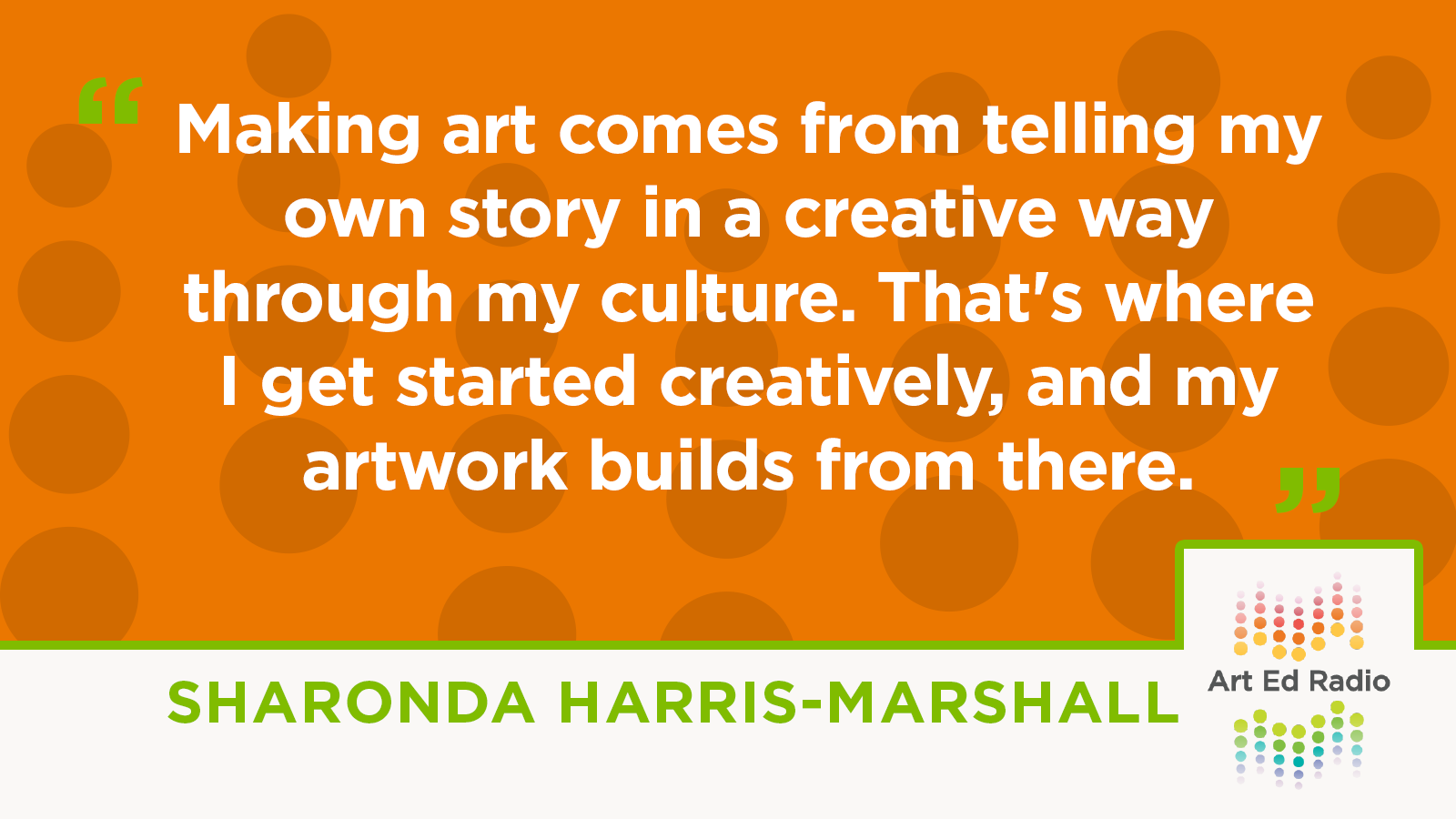
Transcript
Tim: Welcome to Art Ed Radio, the podcast for art teachers. This show is produced by The Art of Education University, and I’m your host, Tim Bogatz.
Earlier this year, and I don’t ask me specifically when, because time feels like it’s lost all meaning at this point in the pandemic, I came across a spectacular article on Medium and it was called Black Art Teachers Matter. It is a great read about just the overwhelming whiteness of the field of art education and why representation matters. About how even a single black art instructor can make such an impact on their students. This article was written by Sharonda Harris-Marshall an artist and art educator, a filmmaker and photographer.
I decided to read on and read some other things that she had written and I loved everything that she had to say. Articles about current events and life in a pandemic and articles about creativity and finding purpose and finding your way as an artist. All of her writing is spectacular. So anyway, I reached out and she and I had talked about how we could connect and maybe collaborate and decided that a podcast would be a good place to start. It took us awhile to put it together, but she is finally here today and I couldn’t be more excited. I think you are going to love hearing from Sharonda.
Before we jump into the interview, though, I want to tell you just a bit about the Art of Education University and everything that we are offering right now. Whether you are teaching fully in-person you’re in some type of a hybrid model, or if you’re doing all remote instruction, we have the resources you need to hopefully find some success in what we know is a really tough situation. And, if you are a Pro or Flex member, we have just libraries full of resources that work for any situation, no matter where you are right now, and new packs and new lessons coming out every month that are responsive to what is happening right now.
Some of our most recent packs include Understanding the Logistics of Teaching Online and Managing Working From Home During an Extended School Closure. If you don’t have Pro or Flex and can’t access those, don’t worry, there are still thousands of resources on the AOEU website waiting for you for free. So check out the Return to Learn page on the site where we have organized resources for everyone, no matter your teaching situation. All right. Sharonda is here and she is ready to go.
All right. Sharonda Harris-Marshall is joining me now. Sharonda, how are you?
Sharonda: I’m great. How are you doing?
Tim: I’m doing really well. I am looking forward to talking to you today and since you have not been on the show, welcome. And I guess to begin, can you just introduce us to yourself? Tell us a little bit about who you are, where you’re from. Talk about your career as an artist.
Sharonda: Okay. Yeah, sure. My name is Sharonda Harris-Marshall. I am an artist originally from Mobile, Alabama. I am now currently, I actually go back and forth between Mobile, Alabama, and Omaha. So I live in Mobile part of the time and I live in Omaha part at the time. I’ve been an artist, I’m kind of a lifelong creative. I have been creative as long as I can remember, as long as I probably have held a crayon in my hand. I went to film school and art school at the University of Southern California. I also have a master’s degree from Spring Hill College, so yeah, it’s just been a lifelong thing for me. I’m a photographer, a filmmaker and a digital media artist, and I teach as well.
Tim: All right. That is a lot. I was just going to say, creativity is always of interest to me, of interest to art teachers everywhere, obviously. So as an artist and as an educator, can you talk a little bit about your creative process, like what creativity looks like for you? And I guess a second part of that, maybe, how do you find the ability to keep creating when you’re busy, when you’re not feeling motivated, or even when you’re just taking on the anxieties of everything that’s happening in the world right now?
Sharonda: Well, even though I see myself as a lifelong creative, creativity really, I don’t want to say it comes natural, because some people feel that people who are just always creative, oh, it just falls in your lap and it comes natural. A lot of the things that are personal projects or projects that I do want to take, that are not for client work, part of my creative process in that is to just look at myself as a person, always try to put myself a little bit into my artwork. So I’ll look at what interests me, which would be things like race relations, my history as a black southerner, and kind of just playing off of that. Like what types of things are part of that culture that I could use in a creative way to tell my own personal story. And that’s kind of just how I get started creatively. A lot of my art kind of builds from that upward, if it’s not client work. Obviously, if it is client work, they basically give you the brief. And then the second part of that question, I already forgot.
Tim: Oh, just talking about how with all of the things that are happening in the world right now, how do you focus yourself? How do you get through that anxiety, that lack of motivation to just keep creating with everything that’s happening right now?
Sharonda: I think feeling like being creative is a gift that keeps me going. I just feel that this is something that I’m blessed to have in a way. So that kind of keeps me going. That keeps me motivated when things are falling apart. I know for creatives, we have a lot of complicated lives and sometimes we just don’t feel like doing things, especially if we’re trying to do, for instance, a personal project and we are bogged down with tedious work to get paid. For me, the motivation to keep going is to always be learning something new. So I always make sure I’m refreshing my skills that would help me. And then usually when I’m refreshing my skills, I get inspired by other artists to continue to create. So it’s almost like a domino effect. If I actually put in the effort to try to learn something or to expand in my knowledge, then obviously I get expired, then I start getting ideas. Then I start getting re-motivated again to work on art.
Tim: Yeah, that’s awesome. I love hearing about that. I love hearing just where people get inspiration from and kind of how they turn that into their own work. I wanted to also ask you to just about, I guess, the art that creatives make and do you think that artists have a responsibility to create art with a purpose? Like, should art be speaking out about current events or working toward a specific cause? What role do you think artists play in addressing those issues?
Sharonda: I do personally feel artists should make with purpose. I do know that there are some artists that are like, “I just draw flowers for myself.” And to me, that’s a purpose. So I feel like when you’re creating, you’re not doing it in a vacuum. You are doing it ultimately possibly to share, even if it’s to share with yourself, you’re sharing it with the world. So artists do tend to have a unique platform that they can use and utilize to bring social issues or social justice or activism on a particular level that may be beneficial to underprivileged or platforms that aren’t well-known.
Tim: Yeah, I think that’s a good point and kind of along some of those same lines, I’ve been reading a ton of what you’ve been writing on medium. You have so many great articles, so many great things to say. I wanted to ask you specifically about an article you wrote that is called Black Art Teachers Matter. It’s all about your own experience in art education, academia, I guess and about what students are missing out on when they only have teachers who are white. So can you maybe expand on those ideas a little bit for this audience and talk about why representation is so important in these artistic spaces?
Sharonda: Sure. I know we’re talking about that article, but I do want to mention the very first article I wrote on medium was about how black parents should encourage their children to engage in arts. It was kind of along that same line of, yeah, representation is needed and quite frankly, the only thing that will increase representation or that would increase diversity or increase underserved voices is to increase the number of people who are a particular group in that particular field. That’s pretty much the only way to do it. To make more black artists. To make more Latino artists. To make more Asian artists. To make more women artists. That’s how it’s going to have to be done.
So in my academic experience, it’s been kind of strange because I’ve been privileged. And I said, so in that first article that I had sort of supportive parents and I also grew up, I was born in the cultural center for my home state. Art is kind of part of the economy of Mobile, because Mobile is the sister city of New Orleans. So definitely a lot of cultural overlap there, so obviously art is very revered, even if people don’t make money with their art. A lot of my creativity growing up as a kid was more indulged by my parents and I was kind of hoping that a lot of people who are kind of pushing their kids either away from art, because they don’t think of it as a viable career or anything would try to steer them back if they are creative and are having that outlet, because obviously you can have jobs making art.
So when I went to school, of course, the more lucrative art for everybody is film, so I ended up going into film. I saw a stark difference between my film school and my art school. So I majored in film and I minored in digital media based imaging, which basically is digital media. In my film school, my film school was fairly diverse, because they already had the platform of, they already had black teachers there. So I had black professors in the film school. I also had a lot of students that were from other areas, even around the world that were going there. There were a lot of black students that were there and they had famous black alum like John Singleton and like Shonda Rhimes. So obviously they had already invested enough in diversity or at least that’s what they think. They invested enough in diversity that it was paying off for the film school. The art school, not so much. I was the only black person at the art school when I was-
Tim: Wow. Wow.
Sharonda: There were people who were other minorities, but I was the only black person. And what I did at the art school was I basically kind of doubled down on all the black art because art education is very white.
Tim: Yes. Yes, it is.
Sharonda: It’s extremely white. I didn’t even know about a lot of famous black artists until I had some art teacher take me aside and was like, “Here are the famous black artists.” Because you hear all about classical or Renaissance. You hear all about these art movements that are very Eurocentric and you don’t even hear, for instance, that Picasso basically stole Cubism from Africa. You don’t hear any of that. You hear the very, Eurocentric and Americentric, because of a lot of American artists as well. You’re hearing a lot of very white voices in art, in art school. And so you had to go out of your way to find the non-white ones. When you’re the only person who is you, you kind of are the token and the representative of that. So I got assigned like Kara Walker a couple of times. It’s like, “Okay, well, I kind of wanted to do something on Barbara Kruger, but here we are, I’m doing Kara Walker. I’m doing Robert Johnson, I’m doing Gordon Parks. Okay.”
But I actually ended up trolling. I used my art to troll the fact that I was a token. One of my final pieces that I submitted for our school was based on The Signifying Monkey, which a lot of people didn’t even recognize or understood, but people who’ve watched Dolomite now on Netflix, now understand. But basically, I made a children’s story book using lines from The Signifying Monkey. And so these people are reading these like curse words that are kind of written as a story book and with the pictures of the Lion and the monkey signified it. They’re just like, “Huh, okay. I guess you get an A.” But I ended up doing that a lot just to kind of cope in art school. That’s a long answer, but trust me, I could talk about it forever.
Tim: No, I think we need to hear these stories. We need to know it, because it’s not an experience that most our teachers are living or have lived. So we appreciate that perspective. I guess just one final question, one final idea I wanted to talk about with you is just maybe some advice for teachers of what we can do in the short term. You have all of these ideas of bringing more diversity in, in the longterm and how we can do that over the course of a lot of years. But what are some things that our teachers can do right now? What actions can we take to support inclusivity in our teaching, in our classrooms and in our communities?
Sharonda: I think the first thing we need to recognize is that art education is broken as far as diversity is concerned. I should have not have been the only black person at the school, obviously. The reason why I’m saying that is that obviously people who want to have inclusion and want to have diversity are very dedicated to it. However, the first thing we have to do is recognize there needs to be a systemic change in the way art is taught.
The reason why I’m saying that now is because there was a particular incident, this wasn’t me, this was a colleague of mine who’s also a black artist, who’s a black teaching artist back in Alabama. He had an incident where they kind of wanted the arts council there, or the people that were in charge were going into this underserved school. And they were trying to get teachers to go into this underserved school. He was a teaching artist, but they didn’t hire him to teach. They hired him to document the white teachers going in and teaching these black kids art, and that’s the wrong approach obviously. Because he was like, “Okay, well I’m an artist, I’m a black artist. I really think that black children would like to see adult black artists teach their class. They can connect to them better. Why are you guys just having me document this as a video?”
Long story short, he fell out with the group and then another artist started another group because he had a similar incident where he was a teaching artist and there were a lot of white people that were coming, going in and they were pretty much holding those white people to a higher standard and pushing them into those underprivileged schools to teach the black kids art. And it was kind of this white savior type of moment. So the advice that I have is first of all, do not do that. The bottom line is you definitely need to reach out to artists of color to teach children of color or to teach students who are of color art, because you can fall through the cracks.
The other thing is to be mindful of how you’re teaching your art. So like I said, art is very Eurocentric. We’re teaching about this artist and that artist and this artist and that artist and unfortunately, now it’s backfiring a little bit, because now you have people in this political climate talking about how black people have no culture. Or they’ll talk about how things are trying to evolve to push black people into this. Basically, it’s the argument of race and intelligence that white people can make art and be intelligent and then the other races are making inferior products of art.
So we do have to be mindful on how we structure and teach art in a way. In my classes, I make sure I include, because I teach photography and video, I make sure I include as many diverse photographers as possible, non-Western photographers, women photographers, et cetera, because I think it’s important to show that you don’t have to be white to like photography. Unfortunately my classes are not as diverse. I am the diversity, but I’m hoping that me teaching that to other people will spark a seed, let’s just say.
Tim: No, I think that is something that definitely can happen, and I think it’s worthwhile to take that approach because of that. So Sharonda, thank you so much for giving us some time, sharing your story, sharing some advice with us. I think this is all very valuable for everybody listening, so thank you.
Sharonda: Thank you very much, Tim, for having me.
Tim: Thank you so much to Sharonda for coming on. I loved hearing her talking about her career, her creative process, and especially that idea on developing skills and just how, when you’re putting in the work that inherently leads to you discovering new artists, new inspirations, new ways of seeing, and that’s something I am going to continue to think about. I also want to thank her for sharing her story and sharing her experiences, because as I told her that’s something that not a lot of us have lived. And so it’s an important perspective and it’s important that we continue to listen and continue to learn.
We will link to her page on Medium, so you can read the Black Art Teachers Matter article, as well as the article on how to encourage kids’ creative endeavors. I definitely hope you take the time to read them both and explore a little bit more of her work. Hopefully we can hear from Sharonda a little bit more soon.
Then just to close, one thing that she said that I think really stood out to me, and maybe the thing I want to leave you with here is the idea that creativity doesn’t necessarily come naturally. The creative process takes some effort, but if you center yourself, explore your interests and find your voice, find what you have to say, it helps make us a little more willing to put in that effort. That goes for both ourselves and our students.
Art Ed Radio was produced by the Art of Education University with audio engineering from Michael Crocker. Thank you for listening, and we’ll talk to you next week.
Magazine articles and podcasts are opinions of professional education contributors and do not necessarily represent the position of the Art of Education University (AOEU) or its academic offerings. Contributors use terms in the way they are most often talked about in the scope of their educational experiences.
